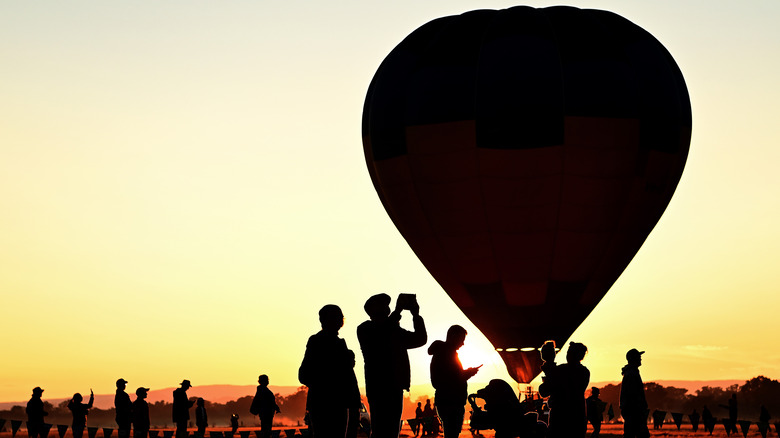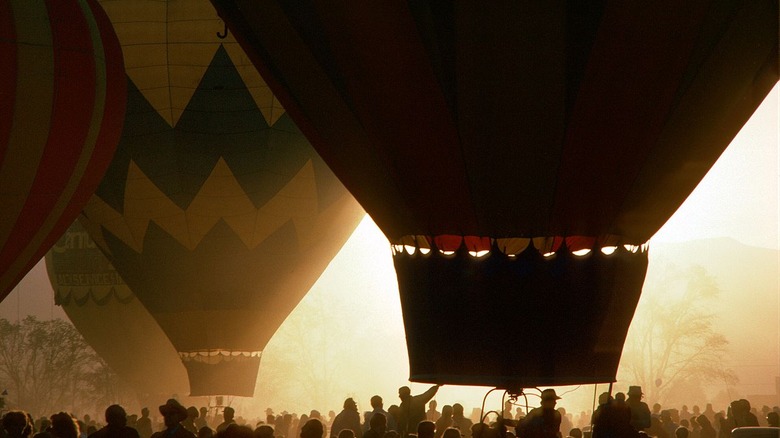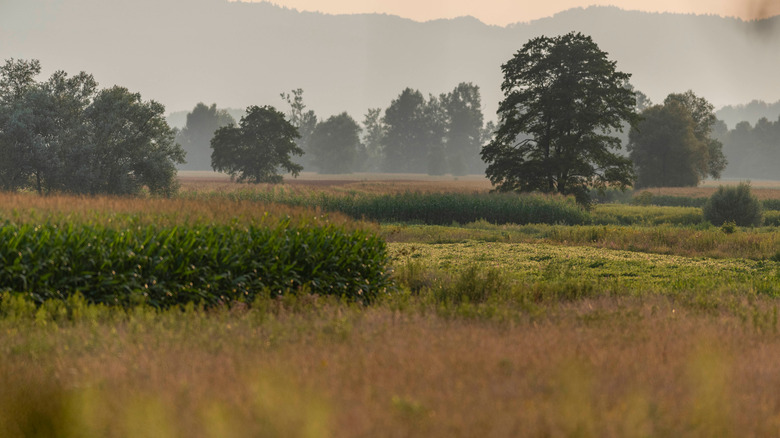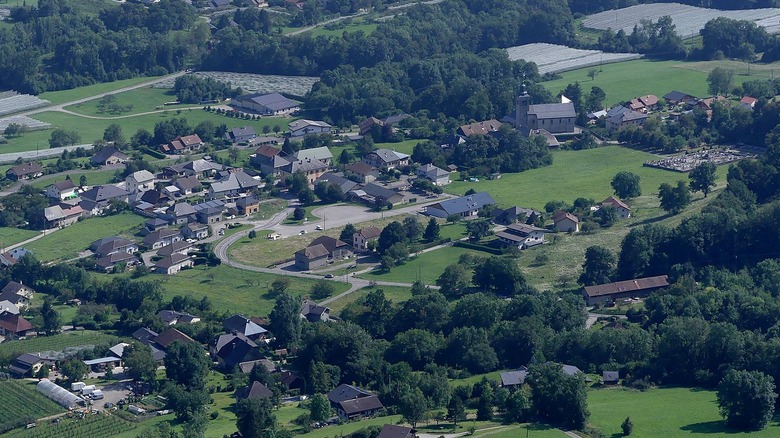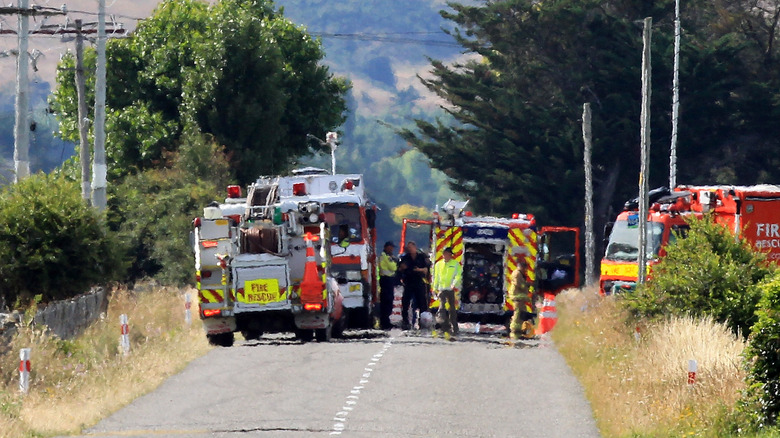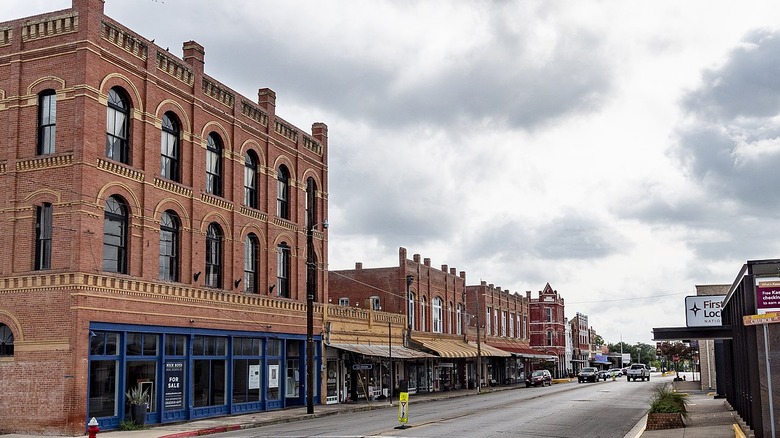The Deadliest Hot Air Balloon Accidents In History
There are countless stories out there documenting aviation accidents – plane crashes and their victims and the reasons behind them. Those stories always make the headlines, with news channels often replaying footage of the catastrophes, so it's no doubt you've seen at least a few of those harrowing crashes.
But plane crashes aren't the only kind of aviation accidents that can occur; humans do have more than one way of taking to the skies, and for that matter, hot air balloons have been around quite a bit longer than planes. Originally pioneered back in the 18th century (via Britannica), hot air balloon rides do come with a number of potential risks. After all, any kind of irreversible damage or poor decisions made hundreds or thousands of feet in the air can easily lead to a very long fall and a very painful death. That's true of just about any form of flight.
So even though hot air balloon accidents might not make the news quite as frequently and generally have lower death tolls, they're still tragic in their own right. Coming about as a result of bad weather, bad luck, or just plain old human error, the stories of hot air balloon accidents are a category all their own. Here's a list of some of the most deadly of all time.
Albuquerque 1982
The city of Albuquerque, New Mexico loves hot air balloons, but who can blame them? Their International Balloon Fiesta looks like such a joyous occasion! And it usually has been, except for the year 1982.
According to the Albuquerque Journal, October 3 was one of the dates for the exciting event, and to feed further into that excitement, the Fiesta had something special: the El Globo Grande, a balloon as tall as a 12-story building. To anyone watching, the voyage of this enormous balloon was smooth sailing (quite literally), even though it was running over max capacity, holding nine people rather than eight. The extra weight apparently wasn't a problem, though, as the balloon seemed to touch down safely post-flight – a cause for celebration. At least until propane suddenly began leaking from the tank, most likely a result of shoddy alterations made to the hoses before takeoff. The propane managed to fall directly into one of the burners, and all of a sudden, this giant balloon became a giant fireball that shot back up into the air. Five people were lucky enough to jump from the balloon while it was still about 20 or 30 feet from the ground, escaping burned and bruised, but alive, per UPI.
The other four passengers weren't nearly as lucky, though, faced with equally grim prospects: jumping from too great a height to survive or being burned alive once the propane tanks exploded. In the following days, the Fiesta ultimately continued, but somber and colored with tragedy as the organizers looked to find a way to remember and honor the four victims.
Barrington Hills 1981
On August 15, 1981, William Keating climbed into a hot air balloon in Barrington Hills, Illinois, expecting to enjoy the trip as a belated birthday gift (via UPI). But the ill-fated balloon ride proved foreboding from the start: Dark clouds could be seen on the horizon, but the pilot and his five passengers assumed things would be fine. After all, it had seemed like those clouds were far enough away to cause no real problems, since the immediate area was clear. That wasn't true at all.
It only took 10 minutes before the storm began rolling in, and the pilot tried to land the balloon. That's where things got dicey, though. A witness told the New York Times that the balloon was beginning to descend when it was suddenly caught by the wind, which pushed it toward – and then up into – nearby power lines. The basket caught fire, the heat sending the balloon soaring up into the air ... at least until the flames also ate through the fabric of the balloon itself, and the burning basket went crashing toward the ground, where the propane tanks exploded.
Five of the six occupants died, according to the Daily Herald (via the Aviation Safety Network). Three of the victims were pronounced dead at the scene. One was pronounced dead on arrival at the hospital, and another died shortly after of severe burns. Rocco Evans was the only survivor – albeit burned and seriously injured from a 100-foot drop – having jumped out of the balloon as soon as he realized it was on fire, a decision that most likely saved his life.
Albuquerque 2021
Albuquerque, New Mexico, is a city that's clearly very proud of its long tradition of hot air balloon rides, with October 2022 marking 50 years of its annual International Balloon Fiesta. But just a year before that big milestone, hot air balloons were at the center of a tragedy.
On the morning of June 26, 2021, near a busy intersection of the city, a balloon rode low in the sky – too low, per the New York Times. The balloon suddenly smashed headlong into some power lines – and with a nearly perpendicular trajectory, adds the Albuquerque Journal – and passersby were alerted to the problem with a sound comparable to gunshots. People rushed out to see as the power lines arced and a fire blazed to life, severing the balloon from the basket. The balloon floated away to land in a suburban neighborhood; the basket fell 100 feet to the ground, killing all five people inside before anyone could arrive at the scene.
Investigators weren't exactly sure what caused the fire or if the balloon was already falling when it hit the power line. (And if so, why was it falling?) Per the New York Times, the autopsy report on the pilot reported that blood and urine samples revealed the presence of both cocaine and marijuana in the pilot's system. The Federal Aviation Administration refused to comment beyond that, but it was enough to enrage the families of at least one of the deceased, who filed a lawsuit against both the estate of the pilot as well as the company he worked for (via AP).
Ljubljana Marshes 2012
Early in the morning of August 23, 2012, in the Ljubljana Marshes of Slovenia, two balloons were high in the sky (via BBC). One landed safely; the other didn't.
Things got turbulent for the ill-fated balloon's 32 passengers as it came time to land. Purportedly, there was a storm raging by that point, and as the balloon lowered to the ground, the landing proved to be, well, rough. The balloon was moving too quickly, dragging along the ground and knocking a few passengers out of the basket, but before long, it was up in the air again. However, that was far from the end of the problems. As explained by the Aviation Safety Network, the balloon stayed in the air for less than a minute before crashing to the ground again – once more at high speed – and eventually running into nearby trees. Somewhere in the mayhem, damage was done to the gas equipment, and the wreckage shortly went up in flames. That was the scene that medics found when they arrived, and initial reports counted four deaths and over 20 injuries, serious enough that 10 people had to be resuscitated at the scene.
But the story of this crash didn't end in 2012. According to the World Atlas, the pilot of the balloon was brought to court for his recklessness during the accident, though he denied any such charges. Word of those accusations disappeared for a few years, until news came out in 2018 (via STA): The pilot had been acquitted (and the official death toll had risen to six, rather than four).
Verrens-Arvey 2001
In the early 1990s, the town of Albertville, France, was best known for hosting the Winter Olympics, but on the morning of August 26, 2001, it became the launching point for a hot air balloon that would undergo one of the deadliest crashes in history. According to CNN, the balloon took off rather inconspicuously from an ice rink; from there, it floated its way between the towns of Clery and Verrens-Arvey, comfortably carrying two families.
But given the entire point of this list, it's pretty clear that things didn't stay comfortable for all too long. As the balloon began to descend, it ended up running into some power lines. Upon doing so (or maybe before – a couple of onlookers reported seeing fire prior to the balloon actually making contact with the wires), the balloon burst into flames, making it rise back up. And as those flames roared, they heated up the gas canisters on board; an explosion was imminent. The people on board panicked, with a few of the passengers climbing over the side, yelling, "Come and help us!" at nearby onlookers, per the Independent.
But none of those onlookers could do much aside from calling the authorities for help (which they did). Then, once the authorities arrived, all they could do was find the bodies of the six victims. Two had been seen climbing over and hanging from the side before falling, dying on impact. Two others were found about a mile away, presumably thrown that distance from the explosion. And the last two were found in the balloon's basket, dead due to severe burns.
Woody Creek 1993
Per the New York Times, in the early 1990s, hot air balloon rides were really starting to take off (pun intended). Although early incarnations had been around since the late 1700s (per Britannica), interest in hot air balloons for leisure was on the rise in the latter half of the 20th century. The stats say it all: the number of balloons available nationwide had risen from about 100 in 1973 to nearly 5,000 in 1993. But the rise in that number also implied the rise of another: the number of deaths caused by ballooning accidents.
AP reported on a deadly accident that occurred on August 8, 1993, in Woody Creek, Colorado, near Aspen. The weather wasn't exactly ideal, and, per CBS6, the balloon and its six riders were caught sidelong by a strong wind that pushed them suddenly off course. And into a power line. With a bright flash, the balloon was cut loose and went flying off into the distance, leaving the basket to free fall for about 100 feet. All six people inside were killed as a result.
Here's the strange part, though. This wasn't the only balloon crash to happen at Woody Creek that year, that month, or even just that week. Only a couple of minutes later, another hot air balloon suffered its own, entirely unrelated, accident. That balloon was similarly blown off course by a strong wind, but it only struck a fence, eventually running across the ground and tipping over; there were a couple of injuries to account for, but fortunately, no deaths.
Carterton 2012
In the early hours of January 7, 2012, the small town of Carterton, New Zealand was rocked by a fiery crash. Per CNN, the day was clear and perfect for a hot air balloon flight, carrying a bunch of locals (11 total, including the pilot) into the sky.
But a clear sky didn't mean a safe flight. Witnesses reported hearing hissing noises and seeing the balloon catch fire before plummeting to the ground; others told the police that they saw the balloon run into nearby power lines before crashing. Though the exact events weren't immediately pieced together, RNZ later explained that the balloon had gotten tangled in the power lines, which then arced, lighting the balloon on fire. The flaming vessel shot up nearly 500 feet in the air; the fall from that height was more than enough to be fatal for all 11 people on board.
But later findings revealed that the pilot could have probably saved the lives of everyone on board. After the balloon had gotten caught, the pilot could have rapidly deflated the balloon – it still would have fallen, but from the more-survivable height of 30 feet – and avoided the damaged balloon flying even higher in the air. The pilot was experienced, so why did he instead try to maneuver the balloon out and over the power lines, risking everyone's lives? Well, it turned out that he probably shouldn't have been flying at all due to an expired medical certificate, but on top of that, the coroner also found cannabis in his system during the autopsy. It's assumed to be the reason behind his lapse in judgment.
Alice Springs 1989
While many hot air balloon accidents involve a single, isolated balloon undergoing a catastrophic failure, that's not necessarily always the case. In a way, it makes sense that multi-balloon incidents would be somewhere on this list. The 1989 crash in Alice Springs is one of those. And to top it off, it just so happened to be the deadliest crash in history, at least at the time.
The incident itself took place on August 13, 1989, in Alice Springs, Australia (via the Associated Press). The balloon took off, carrying a total of 13 passengers – 12 tourists and the pilot – but it wasn't a smooth ascent by any means. On the contrary, as the balloon rose, it ended up colliding with another one already in the air. According to accounts from nearby witnesses, the lower balloon rammed into the basket of the higher one, and, per UPI, a rip began to appear. At that moment, everyone knew things would end badly. The balloons, at this point several thousands of feet in the air, moved apart from each other, and as a witness said, "The [damaged] balloon fell to the ground like a streamer." The pilot had completely lost control, and as the fabric of the balloon itself folded, all 13 occupants experienced a nearly minute-long freefall.
Once investigators found the crash site, they began to paint a picture of what those 53 seconds entailed. 10 of the bodies were all huddled together in the basket, apparently embracing in their last moments before imminent death. But the three other bodies were found some distance away, apparently having jumped from the basket at some point, hoping for better luck.
Lockhart 2016
At 7:30 a.m., Lockhart, a Texas city south of Austin, became the site of the deadliest crash in U.S. history. So, just what exactly happened? According to CNN, the balloon was carrying 16 people when it ran into a power line and caught fire; it didn't take long for the entire thing to go up in flames before crashing to the ground, killing everyone on board.
But things proved to be a bit more complicated than that, as the investigation continued. KSAT later reported just why the balloon might have struck a power line. The weather was overcast and foggy – the pilot claimed he usually "flies between the clouds," but that didn't mean much when he couldn't see where he was trying to land. And, on that note, the pilot himself – Alfred Nichols – was quite the point of interest. Though peers cited him as perfectly competent, further research revealed a medical history that included ADHD – a diagnosis that likely would have prohibited him from flying. But further investigation uncovered even more. Per CBS, an autopsy of Nichols' body found that he was basically doing the hot air balloon equivalent of drunk driving. Valium, opioids, and over-the-counter cold medicines were found in his system, and the cold medicine itself would've had the same effect as a blood alcohol level consistent with drunk driving.
In the years since, the pain of the tragedy still resonates. As KXAN reports, families of the victims lobbied for legislation instituting more safety regulations for hot air balloon flights. That legislation did pass, but even as of 2021, the noticeable effects were pretty negligible, leaving many frustrated with the lack of action.
Luxor 2013
When it comes to hot air balloon accidents, the worst recorded one in history occurred in Luxor on February 26, 2013.
As told by The Guardian, in the midst of a floundering time for the Egyptian tourism industry, recovery seemed to be on the horizon, with tourists from around the world traveling to Luxor to hitch a ride on some hot air balloons. According to CNN, safety measures in this area weren't exactly stellar (a passenger on another balloon said there wasn't a safety briefing beforehand, in case anything should go wrong), but regardless, the trip was mostly fine. At least, it was fine until the end. As the balloon was landing, a cable got caught on one of the gas tanks, and the balloon caught fire. A passenger and the pilot managed to escape before the balloon shot back into the sky – they were the only two to survive – and the rest were killed, either from the burns or from jumping out of the basket. The balloon eventually crash-landed with a loud explosion, starting a fire amidst the sugar cane that could be seen for miles.
Nineteen people in total died in the 2013 incident, but unfortunately, this isn't exactly an isolated case. Luxor has had a fair share of hot air balloon accidents over the years. Prior to the 2013 accident, a massive crash in 2009 made headlines (not counting smaller crashes that same year and in 2007 and 2008), and per The Guardian, tragedy struck again in the years since, with a 2018 crash killing one and injuring a dozen more.
